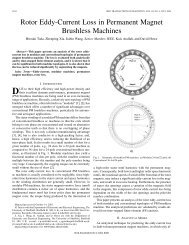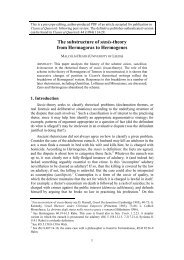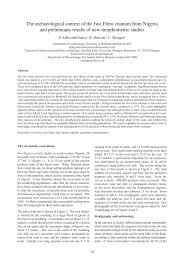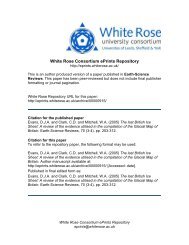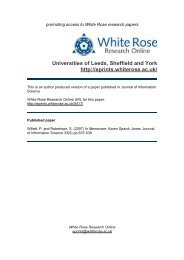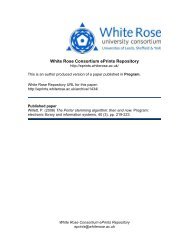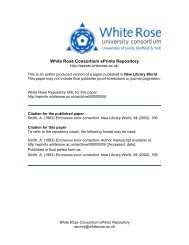The last British Ice Sheet: A review of the evidence utilised in the ...
The last British Ice Sheet: A review of the evidence utilised in the ...
The last British Ice Sheet: A review of the evidence utilised in the ...
You also want an ePaper? Increase the reach of your titles
YUMPU automatically turns print PDFs into web optimized ePapers that Google loves.
south <strong>of</strong> 51820V prompted W<strong>in</strong>gfield (1994) to suggest that <strong>the</strong> Scilly Till probably represents a short-lived<br />
advance by <strong>the</strong> Diml<strong>in</strong>gton Stadial ice stream.<br />
2.3.10. Irish coast<br />
On <strong>the</strong> sou<strong>the</strong>rn Irish coast <strong>the</strong> distribution, orig<strong>in</strong> and age <strong>of</strong> <strong>the</strong> Irish Sea Drifts, particularly <strong>the</strong> enclosed<br />
Irish Sea Till have been at <strong>the</strong> centre <strong>of</strong> controversies over <strong>the</strong> extent <strong>of</strong> <strong>the</strong> <strong>last</strong> glaciation for almost a century<br />
(e.g. Wright and Muff, 1904; Synge, 1981; Warren, 1985). Although <strong>the</strong> Irish Sea Drifts have been<br />
traditionally <strong>in</strong>terpreted as terrestrial glacigenic deposits (e.g. Wright and Muff, 1904; Synge, 1978, 1981;<br />
van der Meer et al., 1994), an alternative glacimar<strong>in</strong>e orig<strong>in</strong> has been proposed by Eyles and McCabe (1989).<br />
Moreover, proposed ages for <strong>the</strong> deposits range from Midlandian/Devensian (Warren, 1985; Gallagher and<br />
Thorp, 1997; McCabe, 1999) to pre-Devensian (Mitchell et al., 1973; Synge, 1981; McCabe, 1987). Recent<br />
sedimentological analysis <strong>of</strong> <strong>the</strong> Irish Sea Till by O´ C<strong>of</strong>aigh and Evans (2002a,b) and Evans and O´ C<strong>of</strong>aigh<br />
(2003) has confirmed a terrestrial depositional orig<strong>in</strong>, imply<strong>in</strong>g <strong>the</strong> onshore movement <strong>of</strong> an Irish Sea glacier<br />
lobe between Cork Harbour and Kilmore Quay dur<strong>in</strong>g <strong>the</strong> <strong>last</strong> glaciation. <strong>The</strong> raised beach that<br />
stratigraphically underlies <strong>the</strong> Irish Sea Till has been dated 162–129 ka BP by <strong>in</strong>frared lum<strong>in</strong>escence<br />
(Gallagher and Thorp, 1997), plac<strong>in</strong>g it firmly <strong>in</strong> <strong>the</strong> age range <strong>of</strong> <strong>the</strong> <strong>last</strong> <strong>in</strong>terglacial. Previous<br />
<strong>in</strong>terpretations depicted an ice marg<strong>in</strong> mov<strong>in</strong>g <strong>of</strong>fshore at Kilmore Quay and <strong>the</strong>n trend<strong>in</strong>g eastwards across<br />
<strong>the</strong> north Celtic Sea. Recession by <strong>the</strong> Irish Sea glacier resulted <strong>in</strong> <strong>the</strong> damm<strong>in</strong>g <strong>of</strong> <strong>the</strong> local dra<strong>in</strong>age along<br />
<strong>the</strong> south coast and <strong>the</strong> deposition <strong>of</strong> glacilacustr<strong>in</strong>e sediments <strong>in</strong> ice-dammed lakes. Glacitectonic<br />
disturbance <strong>of</strong> <strong>the</strong> lake sediments by ice <strong>of</strong> <strong>in</strong>land orig<strong>in</strong> documents <strong>the</strong> Midlandian glaciation <strong>of</strong> <strong>in</strong>land areas<br />
<strong>of</strong> sou<strong>the</strong>rn Ireland previously thought to be covered by pre-Midlandian tills. <strong>The</strong> bouldery ridge <strong>of</strong> St<br />
Patricks Bridge and o<strong>the</strong>r arcuate ridges located to <strong>the</strong> east are ice marg<strong>in</strong>al accumulations deposited by <strong>the</strong><br />
Irish Sea glacier as it retreated from <strong>the</strong> sou<strong>the</strong>ast Irish coast. O´ C<strong>of</strong>aigh and Evans (2002a,b) and Evans and<br />
O´ C<strong>of</strong>aigh (2003) suggest that <strong>the</strong> Irish Sea Till on <strong>the</strong> sou<strong>the</strong>rn Irish coast is <strong>the</strong> onshore record <strong>of</strong> <strong>the</strong><br />
short-lived (rapid or surge) advance <strong>of</strong> <strong>the</strong> Irish Sea lobe recorded <strong>in</strong> <strong>the</strong> Celtic Sea and on <strong>the</strong> Scilly Isles.<br />
Scottish Highland ice advance <strong>in</strong>to Nor<strong>the</strong>rn Ireland is recorded by a lower till sheet <strong>in</strong> County Down that<br />
conta<strong>in</strong>s Ailsa Craig microgranite erratics and shells radiocarbon dated at 24,050±650 BP (I-3268). If <strong>the</strong><br />
date is correct it provides a maximum age on <strong>the</strong> advance <strong>of</strong> glacier ice onto Nor<strong>the</strong>rn Ireland. An upper till <strong>of</strong><br />
local derivation records <strong>the</strong> later expansion <strong>of</strong> Irish ice to exclude Scottish Highland ice from County Down<br />
and <strong>the</strong> coast <strong>of</strong> County Antrim (Hill and Prior, 1968).<br />
3. Summary and discussion <strong>of</strong> <strong>the</strong> <strong>evidence</strong> for <strong>the</strong> <strong>last</strong> (Diml<strong>in</strong>gton Stadial) <strong>British</strong> <strong>Ice</strong> <strong>Sheet</strong><br />
3.1. <strong>The</strong> vertical limits <strong>of</strong> <strong>the</strong> ice sheet<br />
Recent developments <strong>in</strong> <strong>the</strong> cosmogenic isotope dat<strong>in</strong>g <strong>of</strong> mounta<strong>in</strong> summit blockfields <strong>in</strong> upland Brita<strong>in</strong> (e.g.<br />
Ballantyne et al., 1998a,b) has given Quaternary researchers confidence <strong>in</strong> identify<strong>in</strong>g LGM nunataks and<br />
52




